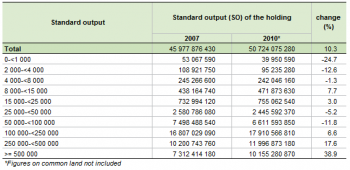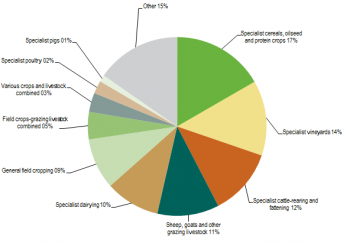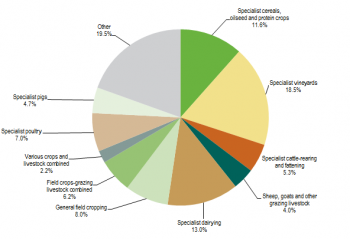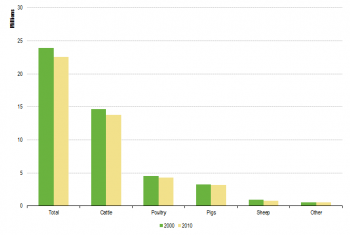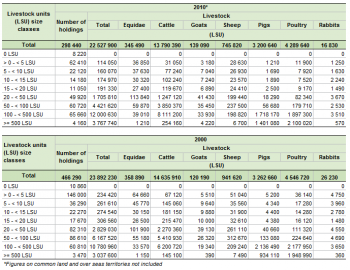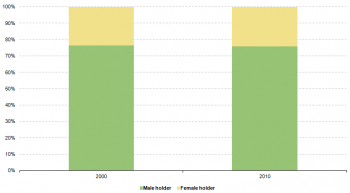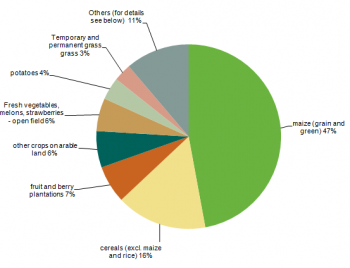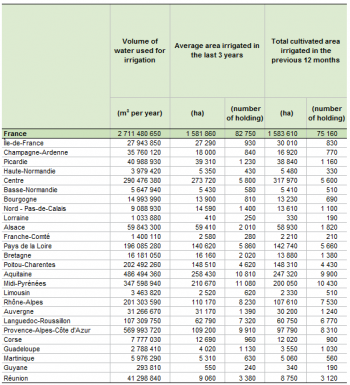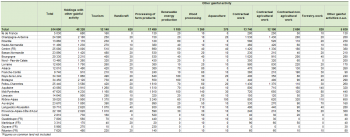Archive:Agricultural census in France
This article has been archived.
This article is part of a series of country-specific essays on the results of the European Union (EU) Farm structure survey (FSS) 2010. The FSS collects information on the structural characteristics of agricultural holdings (land use, livestock and labour force) and is carried out by all European Union Member States every 10 years as an Agricultural census, with two or three additional, intermediate sample surveys carried out in-between.
The present analysis of the farm structure includes a comparison with the Agricultural census 2000. In contrast to the FSS 2010, the Agricultural census 2000 did not include information on the “Départements d’outre-mer”. Furthermore, in France the Agricultural census 2010 was the first one to collect information on common land. As a result, in order to allow comparison between the two reference years, 2010 data presented throughout this article do not include information on common land and the overseas territories when the analysis is conducted at national level. For the regional analysis, only information on common land was filtered out of the 2010 data set.

Source: Eurostat (ef_kvaareg) (ef_ov_kvaa) (demo_pjan) and FSS 2000 and 2010

Source: Eurostat (ef_kvaareg) (ef_ov_kvaa) and FSS 2000 and 2010
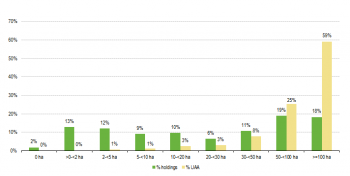
Source: Eurostat (ef_kvaareg) (ef_ov_kvaa)
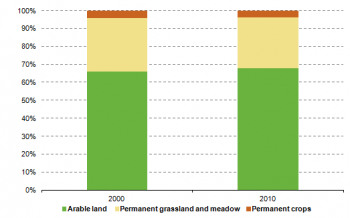
Source: Eurostat (ef_lu_ovcropaa) (ef_oluaareg)

Special value: ":" not available
Source: Eurostat (ef_lu_ovcropaa) (ef_oluaareg)
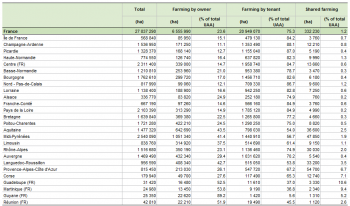
Source: Eurostat (ef_mptenure)

Source: Source: Eurostat (ef_pmhouscatlaa)
Main statistical findings
Key indicators
According to the FSS 2010, there were about 490 000 agricultural holdings in metropolitan France (see Table 1). Despite the fact that the population of farms decreased by one quarter compared to 2000 (- 173 830), in 2010 France was among the EU Member States with the highest number of holdings.
The utilised agricultural area (UAA), on the other hand, remained quite stable over the inter-census decade, only decreasing by 3.2 %: there were about 27.0 million hectares of UAA in 2010, compared with 27.9 million ha in 2000. As a result, agricultural land covered 43 % of French national territory and was the largest across the whole EU-27 in 2010.
As the fall in the number of holdings was more pronounced than the decrease in agricultural land, the average size of holdings increased strongly, from 42 ha per farm in 2000 to 55 ha in 2010. This tendency, common throughout the EU Member States, suggests that the structure of the French agriculture is changing in the sense that large holdings are replacing smaller ones.
In France, the number of persons regularly working in the agricultural sector dropped by 26.7 % over the decade under analysis. 1.3 million persons were working on farms in 2000, while the number dropped below the one million threshold in 2010 (966 300). Accordingly, the agricultural labour force represented only 3.6 % of the active population[1] of France in 2010.
Although in 2010 France recorded the largest population of livestock among the EU Member States, this dropped between the two reference years (- 5.7 %): from about 23.9 million livestock units (LSU) in 2000 to 22.5 million LSU in 2010.
Regional key indicators
The regional analysis presented in Table 2 sheds light on the local characteristics of French agriculture. In terms of the number of holdings, no region appears to play a major role as no territory recorded a double digit share of the total. Indeed, farms appeared to be distributed quite equally across the whole country, with the exception of the metropolitan area of Île-de-France, Corse and the overseas territories, all of which had fewer farms. The region of Midi-Pyrénées recorded the highest share (9.3 %), with 47 620 farms recorded within its borders in 2010. Aquitaine recorded the second highest number (43 060) and accounted for 8.4 % of the total, slightly higher than Rhône-Alpes (7.6 %) where 39 020 farms were recorded in 2010. This is consistent with the ranking of the regions in terms of total area, as Midi-Pyrénées is the largest area, followed by Aquitaine and Rhône-Alpes.
The regions of Centre and Midi-Pyrénées recorded the largest agricultural areas. According to the FSS 2010 data, the agricultural area covered 2.3 million hectares within the territory of Centre, 8.5 % of the total French UAA in 2010 – the same as in 2000. The agricultural area was slightly smaller in the region of Midi-Pyrénées (see table 2), though it accounted for the same share (8.5 %) of the country’s UAA in 2010. With 2.1 million hectares of agricultural area recorded in 2010, Pays de la Loire was the only other region recording a value higher than the 2 million hectares threshold in 2010: it accounted for 7.8 % of French agricultural land.
In terms of animal livestock units (LSU) the distribution of French agricultural resources appears more distorted, with Bretagne and Pays de la Loire standing out: 4.6 million LSU were recorded within the borders of Bretagne in 2010, 20.6 % of the French farm animal population; Pays de la Loire accounted for 15 %, with 3.4 million LSU registered within its territory.
The agricultural labour force was fairly equally distributed across the country, with no region recording a double digit shares. Aquitaine accounted for 9.1 % of the French regular agricultural labour force. The second highest share was recorded within the territory of Midi-Pyrénées, with 83 930 people, or 8.3 % of the French regular agricultural labour force, regularly working on farms in 2010.
There were marked regional differences in the average area of agricultural holdings. Far from being a French peculiarity, this characteristic was observed in many EU Member States. In particular, with the exclusion of the overseas territories which are characterised by small sized farms, 2010 values ranged from the 27.6 hectares per holding of Provence-Alpes-Côte d'Azur to the 113.1 ha of Île-de-France. This phenomenon may be partially explained by the prevalence of annual crops in Île-de-France and perennial crops in Provence-Alpes-Côte d'Azur.
Agricultural holdings
As shown in Figure 1, holdings with 50 to 99.9 hectares of agricultural area were the most common in France. In 2010, 97 780 of them were recorded, 19 % of the total number of agricultural holdings. In addition, these holdings accounted for one quarter of French agricultural area, covering 7.1 million hectares of UAA. Farms with 100 hectares or more of agricultural land were also very significant; they took up 59 % of French agricultural land and represented 18 % of the total number of French farms (94 250).
Together, farms with 30 hectares or more of UAA accounted for about half of all agricultural holdings and covered 92 % of French UAA in 2010.
See detailed data at NUTS 2 level for 2000 and2010
Economic size of the farm
In 2010, the economic size of French agricultural holdings was EUR 50 724 million (see Table 3). This value, which is calculated by summing up all the standard output (SO) per hectare of crop and per head of livestock of the farms, was the highest recorded within the EU-27. Compared to the FSS 2007 (EUR 45 978 million), the economic size increased by 10.3 %. In particular, significant increases were recorded by the largest classes of farms: those with a size of EUR 100 000 to 249 999 (+ 6.6 %), farms of EUR 250 000 to 499 999 (+17.6 %) and farms of EUR 500 000 or more (+38.9 %). In addition, these three categories were by far the most significant, as together they accounted for 79 % of the standard output of France in 2010 (EUR 40 063 million) – in 2007 they had an SO of EUR 34 320 million and accounted for 75 % of the total SO.
As for the number of holdings and the agricultural area, the structure of French agriculture proved to be quite balanced in the geographical distribution of its economic output. Bretagne and Pays de la Loire were the only two territories which recorded values greater than the EUR 5 000 million threshold. According to the FSS 2010, the region of Bretagne had an output of EUR 5 834 million and accounted for 11.5 % of the French SO, while the region of Pays de la Loire registered EUR 5 181 million, corresponding to 10.2 % of the country’s standard output.
See detailed data at NUTS 2 level for 2010 and 2007
Agricultural holding by main type of farming
In terms of the number of holdings, farms specialised in the production of cereals, oilseed and protein crops were the most common (17 %) in 2010 in France. The second highest share was recorded for holdings dedicated to vineyards (14 %), confirming the country’s long-standing tradition of the production of wine. Holdings specialised in cattle rearing and fattening accounted for 12 % of the total population of farms, while holdings dedicated to goats and other grazing livestock (11 %), and those specialised in dairying (10 %), were the only other types that recorded double digit percentages.
In terms of economic size, agricultural holdings specialised in vineyards were the most important, accounting for 19 % of total agricultural output in 2010. Farms specialised in dairy farming recorded the second highest share (13 %), followed by those dedicated to the production of cereals, oilseed and protein crops (12 %). Agricultural holdings specialised in general field cropping accounted for 8 % of the French agricultural output.
See detailed data at NUTS 2 level for 2010
Land use
The Utilised Agricultural Area (UAA) is the total area used by the farm, regardless of the type of tenure or whether it is used as a part of common land. The agricultural area is made up of four major components: arable land, permanent grassland and meadow, permanent crops and kitchen gardens. In France, the UAA decreased moderately (-3.2%), a change that can be attributed to the decreasing area of permanent grassland.
In 2010 arable land accounted for 67.9 % of the total agricultural area, and permanent grassland and meadow for 28.3 % (see Table 4). These two categories together covered 26 million hectares of UAA and accounted for 96.2 % of the French agricultural area in 2010, compared with 95.6 % in 2000, when they took up about 27 million hectares. Permanent crops covered about 1.0 million hectares in 2010, accounting for 3.7 % of the UAA.
See detailed data at NUTS 2 level for 2000 and2010
Arable land
In France, arable land is essentially taken up by cereals, fodder crops and industrial crops, which together accounted for 61 % of the total agricultural area in 2010. In particular, in 2010 9.2 million hectares were dedicated to the production of cereals: at 34.2 % of French agricultural land, this was an increase of 2.2 % compared with 2000. The area dedicated to fodder crops also grew between the two reference years (+5.1 %), reaching 4.9 million hectares or 18.2 % of the French UAA in 2010. Within arable land, industrial crops recorded the highest increase (+12 %), as the area dedicated to their production rose from 2.1 million hectares in 2000 to 2.4 million ha in 2010. The area lying fallow almost halved to 624 340 hectares in 2010.
See detailed data at NUTS 2 level for 2000 and 2010
Permanent grassland
In France, the area of permanent grassland decreased by 8.2 % over the inter-census decade (- 681 700 ha). Its composition did not change significantly, as land dedicated to pasture and meadow still played the main role in 2010, accounting for 23 % of the UAA compared with 25 % in 2000. The area covered by rough grazing areas accounted for 5 % of the French UAA in both reference years.
See detailed data at NUTS 2 level for 2000 and 2010
Livestock
Statistics on livestock use two different units of measurement, the number of head (number of animals) and livestock units (LSU), with the latter allowing comparison between different types of livestock.
As shown in Table 5, about 22.5 million LSU were recorded in France in 2010. This value, which was the highest within the EU-27, does not take into account holdings located in the overseas territories of Guadalupe, Martinique, Guyane and La Réunion[2]. In relative terms, there were 0.36 LSU per inhabitant in 2010, slightly lower than in 2000 (0.41), as the French population increased (+6.6%) while the number of livestock decreased (-5.7 %) over the inter-census period.
According to the FSS 2010, cattle were by far the most important category of livestock in France: the cattle population was about 14 million LSU and represented 61 % of the total population of farm animals. Compared to 2000, the cattle population decreased by 5.8 %. Poultry were the second most important type of farm animal and accounted for 19 % of French livestock in 2010, when 4.3 million LSU were recorded; in 2000 the corresponding value was 4.5 million LSU (-5.7 %). The number of pigs was fairly stable over the period under analysis; 3.2 million LSU were registered in 2010, accounting for 14.2 % of the French livestock population.
As the decrease in the number of farms with livestock (36 %) was sharper than the fall in the number of agricultural holdings (26.2 %), the relative weight of holdings with livestock in the total population of farms dropped within the 2000-2010 timeframe, from 70 % to 61 %. In particular, this share decreased for every class of farms with livestock, with the exception of the two largest ones: the number of farms with 100 to 499 LSU increased by 8 % and farms with 500 LSU or more grew by 20 %. On the other hand, agricultural holdings with 20 to 49 LSU recorded the biggest drop (-39.4 %), followed by those with 5 to 9 LSU (-39 %).
See detailed data at Nuts 2 level for 2010 and 2000
Labour force
According to the FSS 2010, 966 290 people were working on French farms. Despite this being one of the highest figures recorded among EU Member States, it represented a decrease of 26.7 % compared with 2000, when over 1.3 million people were working in the agricultural sector. In terms of annual work units (AWU), the decrease was less severe (-22.8 %), dropping from 855 660 AWU in 2000 to 660 780 AWU in 2010.
Among the French territories, the region of Aquitaine recorded the highest number of agricultural employees working on a regular basis: there were 92 610 of them in 2010 accounting for 9.1 % of the French regular agricultural labour force. The territory of Midi-Pyrénées registered the second highest share (8.3 %), with 83 930 people employed on a regular basis on farms within its borders, while Rhône-Alpes and Pays de la Loire recorded the third highest percentage (7.3 % each).
In France, the gender gap in sole holders was smaller than in most other countries, as 24.2 % of sole holders were female, a small increase compared to 2000 (23.5 %).
See detailed data at NUTS 2 level on holders' age and gender for 2010 and 2000
See detailed data at NUTS 2 level on type of labour force for 2010 and 2000
Management practices
Type of tenure
In France, three quarters of the agricultural area, about 21 million hectares, were farmed by tenants in 2010. As shown in Table 7, particularly high percentages of land under this type of tenure were recorded in Champagne-Ardenne (88.1 %) and Picardie (87 %). On the other hand, outside Metropolitan France, the share of land farmed by tenants was significantly lower: in Guyane only a marginal 5 % of the agricultural area was farmed by tenants in 2010.
In France, 6.5 million hectares of UAA (23.6 %) were farmed by the persons who owned that land in 2010. In particular, the region of Champagne-Ardenne recorded the lowest share (11.1 %) together with the northern territory of Nord-Pas-de-Calais (12.1 %). At the other end of the scale, the overseas territories registered higher shares, as between 51.9 % (Réunion) and 89.2 % (Guyane) of their agricultural areas were under this type of tenure in 2010.
The French agricultural area utilised in partnership by the landlord and the sharecropper under a written or oral share-farming contract – or the area utilised under other modes of tenure – covered a marginal 1.2 %, corresponding to 332 230 hectares. Among the French territories, significant values were recorded in the overseas territory of Guadalupe, where land under this type of tenure took up 10.6 % of the UAA, as well as Martinique where it accounted for 9.4 %.
Irrigation
In France, the total irrigable area decreased by 11.1 % within the period under analysis (from 2.6 million ha to 2.3 million ha). In contrast, the irrigated area, which includes all green houses and some kitchen gardens (depending on the characteristics of their irrigation), remained fairly stable (+ 0.5 %). However, when analysing data on irrigation, it should be kept in mind that the extent of the irrigated area may vary between years depending on weather conditions.
In terms of the type of crops, the crop that used the largest share of irrigation water was maize (grain and green). According to the FSS 2010, this kind of crop took up 749 490 ha of irrigated area and accounted for 47.1 % of the total irrigated area in France. With 252 860 ha of irrigated area, cereals (excluding maize and rice) were the second most irrigated crop (15.9 %), followed by fruit and berry plantations – 104 140 ha, corresponding to 6.6 % of the total irrigated area.
In terms of the volume of water, 2 711 million cubic metres of water were used to irrigate the agricultural area in France. In relative terms, 1 712 cubic metres of water per hectare of agricultural land were used in 2010, calculated taking into account the area irrigated in the 12 months prior to the survey. Within this context, it must be remembered that the water used for irrigating kitchen gardens was partially included in the calculation, depending on the characteristics of the irrigation. Water used for irrigating areas under glass was always recorded as irrigation water. The figures for irrigation water are quite accurate as water counters are compulsory in France. When interviewees could not answer the question (about 10 % of the cases), they were asked to give an estimation.
The amount of water used in agriculture strongly depends on the region and its peculiarities. Accordingly, values significantly lower than the national average were recorded in the regions of Franche-Comté (634 cubic metres per hectare), Corse (647 cubic metres per ha), Nord-Pas-de-Calais (668 cubic metres per hectare) and several others. On the other hand, values significantly higher than the average were recorded for Provence-Alpes-Côte d'Azur (5 829 cubic metres per ha), Réunion (4 720 cubic metres per ha) and Lorraine (3 133 cubic metre per ha).
Animal housing
Among the 27 EU Member States, France had one of the highest populations of holdings with cattle. According to the FSS 2010, there were 199 620 holdings rearing 19.5 million head of cattle.
Both in terms of the number of holdings and the number of places, the most common type of animal housing was loose with solid dung and manure (see Table 9). In France, this type of housing was recorded for 147 750 holdings and accounted for about 15 million places.
If the number of places is taken into account, the second most frequent type of animal housing was where cattle are loose with slurry (2.2 million). On the other hand, in terms of holdings, the second most common type of housing was that where animals are tied with solid dung and liquid manure (49 690 holdings).
Other gainful activities
In 2010, there were 48 320 holdings with other gainful activities carried out within the framework of the holding as a legal unit in France, corresponding to 9.4 % of the total population of holdings.
Information on other gainful activities was collected by eleven activity categories – each holding could register more than one activity. As shown in Table 10, processing of farm products (17 490 farms) was the most common extra source of income, followed by contractual work – which could take the form of contractual agricultural work (12 100 holdings) and contractual non-agricultural work (2 690 farms). In addition, tourism (12 140 farms) proved to be quite significant as another gainful activity.
See detailed data at NUTS 2 level for 2000
Organic farming
Organic agriculture is an ecological production management system that promotes and enhances biodiversity, biological cycles, and soil biological activity. It is based on the minimal use of off-farm inputs and on management practices that restore, maintain or enhance ecological harmony.
The UAA under organic farming in France increased over the period under analysis, accounting for 1.8 % of the whole UAA of the country in 2010. As shown in Table 11, it grew from 385 980 hectares in 2003 to 496 860 in 2010 (+29 %) – no data are available for 2000.
See detailed data at Nuts 2 level for 2010, 2007, 2005, 2003 and 2000
Data sources and availability
Methodological notes France – Agricultural census 2010
In France, the Agricultural Census 2010 was carried out by the Statistics Department of the Ministry of Agriculture in compliance with EU regulations.
Survey on agricultural production methods (SAPM)
In 2010 a unique survey was carried out together with the Agricultural census, the Survey on agricultural productions methods (SAPM). This survey collected data at regional level needed to establish agri-environmental indicators as indicated in COM final 508/2006 and to evaluate the greening of the Common agricultural policy.
Data were collected according to the specifications listed in Annex V of the above mentioned regulation, namely data on tillage methods, soil conservation, landscape features, animal grazing, animal housing, manure application, manure storage and treatment facilities and irrigation.
In France, the SAPM was conducted as an exhaustive survey: the same threshold applied to the Agricultural census was used for the Survey on Agricultural Production Methods. Accordingly, the smallest holdings, which altogether acconted for less than 2 % of the total UAA and for less than 2 % of the total number of livestock, were not within the target population.
Reference period
Information related to production methods and the labour force was collected with reference to the agricultural year 2009-2010: from 1st of November 2009 to the 31st of October 2010. Data on livestock were collected with reference to the 31st of November 2010. Information on support for rural development was collected with reference to the years 2008, 2009 and 2010.
Threshold for agricultural holdings
In France, the same threshold was used for surveying both the FSS and the SAPM. In particular, the target population included all farms with at least one hectare of agricultural land; this was also the case in the previous waves of the FSS. Furthermore, agricultural holdings with less than one hectare of agricultural land complying with a set of physical thresholds were also included in the target population of both the FSS and the SAPM. The physical thresholds – related to the hectares of certain types of crops or head of cattle – set for the Départements d’outre-mer differ from those used for continental France.
Common land
Common land is land that does not directly belong to any agricultural holding but on which common rights apply. It can consist of pasture, horticultural or other land. The treatment of common land used by an agricultural holding might differ from country to country.
In France, information on the area of common land was collected for the first time within the context of the Agricultural census 2010. French common land comprises about 750 000 hectares of permanent grassland used for common pasture. This common land is attributed to special agricultural holdings for which only information on UAA and labour force was collected. In order to allow comparison between 2000 and 2010, 2010 data presented throughout this article do not include information on common land when compared with 2000 data.
Geo-reference of the holding
Information on the geographical location of the agricultural holdings was collected through a specific question of the questionnaire.
Economic size
From FSS 2007 onwards, the Standard output (SO), a new classification of the economic size of the holding, is used. The SO has replaced the Standard gross margin (SGM) used before. Nonetheless, for comparability reasons, in FSS 2007 both classifications are available.
Volume of irrigation water
This characteristic was calculated for the first time in 2010 within the context of the SAPM. Water meters are mandatory in France; therefore interviewees had no problems responding to the questions related to the volume of water used for irrigation. If, for any reason, they could not respond – roughly 10 % of cases – they were invited to give estimations. Water used for greenhouses was included in the calculation, while water used for irrigating kitchen gardens could be included or excluded depending on the irrigation system used.
Other methodological issues
The Agricultural census 2000 did not include information on the “Départements d’outre-mer”; it only collected data on “France metropolitan”. In contrast, data on the overseas regions[3] were collected for the Agricultural census 2010. In order to allow comparison between 2000 and 2010, 2010 data presented throughout this article do not include information on the overseas territories when the analysis is conducted at national level.
Context
European Commission Rural development policy aims to improve competitiveness in agriculture and forestry, the environment and the countryside, as well as to improve the quality of life in rural areas, and to encourage the diversification of rural economies.
As agriculture has been modernised and the importance of industry and services within the economy has increased, agriculture has become much less important as a source of jobs. Consequently, increasing emphasis is placed on the role farmers can play in rural development, including forestry, biodiversity and the diversification of the rural economy, in order to create alternative jobs and provide environmental protection in rural areas.
The FSS continues to adapt in order to provide timely and relevant data to help analyse and follow these developments.
See also
- Agricultural census 2010
- All articles on France
- All farm structure articles by country
- Farm structure statistics
Further Eurostat information
Publications
- Agriculture, fishery and forestry statistics — Main results – 2010-11 - 2012 edition
- Farm Structure Survey in France - 2007 - Issue number 84/2009
- Farm Structure in France - 2005 - Issue number 42/2007
- Structure of Agricultural Holdings - France 2003 - Statistics in focus 8/2005
Main tables
- Agriculture, see:
- Farm structure: historical data (1990-2007) (t_ef)
Database
- Agriculture, see:
- Farm structure (ef)
Dedicated section
Methodology / Metadata
- Farm structure (ESMS metadata file — ef_esms)
- Methodological Report - FSS 2007 France
- Methodological Report - FSS 2010 France
Source data for tables and figures (MS Excel)
Other information
- Regulation 1166/2008 of 19 November 2008 on farm structure surveys and the survey on agricultural production methods and repealing Council Regulation 571/88
- Regulation 1200/2009 of 30 November 2009 implementing Regulation 1166/2008 on farm structure surveys and the survey on agricultural production methods, as regards livestock unit coefficients and definitions of the characteristics
External links
Notes
- ↑ A value calculated over the active population in the 4th quarter 2010 of the EU Labour force survey (LFS) Population, activity and inactivity - quarterly data
- ↑ The territories of Saint-Martin, Saint-Barthélemy and Mayotte were not included in either the FSS 2000 or the FSS 2010.
- ↑ The territories of Saint-Martin, Saint-Barthélemy and Mayotte were not included in the survey in both reference years.
